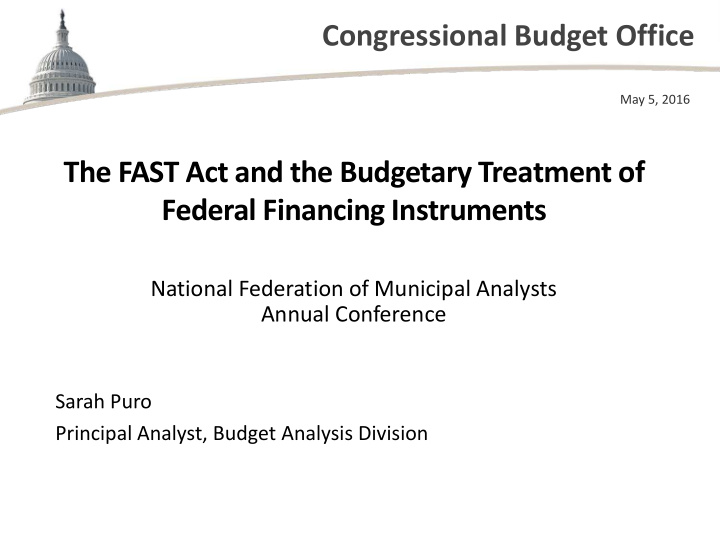



Congressional Budget Office May 5, 2016 The FAST Act and the Budgetary Treatment of Federal Financing Instruments National Federation of Municipal Analysts Annual Conference Sarah Puro Principal Analyst, Budget Analysis Division
Federal, State, and Local Governments’ Shares of Spending on Transportation and Water Infrastructure Capital Operation and Maintenance ($181 Billion) ($235 Billion) Federal Government: $27 Billion (12%) Federal Government: $69 Billion (38%) State and Local Governments: State and Local $112 Billion Governments: (62%) $208 Billion (88%) 1 CONGRESSIONAL BUDGET OFFICE
The FAST Act and the Status of the Highway Trust Fund 2 CONGRESSIONAL BUDGET OFFICE
The FAST Act provides $281 billion in contract authority for all surface transportation programs through 2020 and authorizes appropriations of another $25 billion , most of which is for transit and rail programs. 3 CONGRESSIONAL BUDGET OFFICE
The FAST Act also: • Provides $275 million to $300 million per year for loan and loan guarantee programs under the Transportation Infrastructure Finance and Innovation Act (TIFIA), • Allows states to transfer funds allocated by formula for TIFIA’s subsidy cost, and • Makes changes to the Railroad Rehabilitation and Improvement Financing program . 4 CONGRESSIONAL BUDGET OFFICE
The FAST Act transfers $70 billion from the general fund of the Treasury to the Highway Trust Fund, mostly from remittances to the Treasury from the Federal Reserve, but does not generate any new revenue from transportation users. 5 CONGRESSIONAL BUDGET OFFICE
Estimated spending from the Highway Trust Fund exceeds its revenues. Under CBO’s baseline projections, the transit and highway accounts may have difficulty meeting all obligations by 2021 and 2022 , respectively. 6 CONGRESSIONAL BUDGET OFFICE
Actual and Projected Receipts, Outlays, and Balance or Shortfall for the Highway Account Under the March 2016 Baseline, 2006 to 2026 Billions of Dollars 100 Actual Projected 80 Outlays 60 40 Receipts 20 0 -20 End-of-Year -40 Balance or Shortfall -60 -80 2006 2008 2010 2012 2014 2016 2018 2020 2022 2024 2026 7 CONGRESSIONAL BUDGET OFFICE
Budgetary Treatment of Federal Financing Instruments 8 CONGRESSIONAL BUDGET OFFICE
Some proposals involve establishing a new entity to finance infrastructure investments. Even if such an entity is not officially a federal agency, its activity might be considered part of the federal budget. 9 CONGRESSIONAL BUDGET OFFICE
What activities are recorded as part of the federal budget? 10 CONGRESSIONAL BUDGET OFFICE
“ Borderline agencies and transactions should be included in the budget unless there are exceptionally persuasive reasons for exclusion.” —President’s Commission on Budget Concepts (1967) 11 CONGRESSIONAL BUDGET OFFICE
In CBO’s estimate, any entity that is financed by federal funds and subject to federal control is included in the federal budget. Activities do not have to be conducted by a federal agency to be classified as governmental and included in the budget. 12 CONGRESSIONAL BUDGET OFFICE
How does the federal budget treat loan and loan guarantee programs? 13 CONGRESSIONAL BUDGET OFFICE
Under the Federal Credit Reform Act of 1990 (FCRA), the cost of loans and loan guarantees is recorded as the net present value of the cash flows to and from the government when the loan is disbursed (accrual accounting). That net present value is the subsidy cost . 14 CONGRESSIONAL BUDGET OFFICE
A Simplified Credit Reform Model The loan is $100. Treasury disburses the $100 Loan recipient loan amount ($100) and receives payments Annual repayments and interest payments Disbursement and repayment of the loan (and interest payments) are not recorded in the federal budget because those transactions are only “financing” cash flows. The federal budget shows: Appropriation to agency ($10) Agency calculates the subsidy rate Agency records a (10%) and awards the ($100) loan cost of $10 15 CONGRESSIONAL BUDGET OFFICE
Under FCRA, for direct loans, principal repayments and interest payments are not available to revolve into new loans . Those receipts are accounted for in the estimated net present value of the loan. Spending of such receipts would require additional authority and result in additional costs. 16 CONGRESSIONAL BUDGET OFFICE
Borrowing is not a receipt . Bond proceeds or repayable equity investments are a means of financing a project—not the ultimate source of capital—and are not treated as federal receipts. 17 CONGRESSIONAL BUDGET OFFICE
Notes about slide 7: CBO’s baseline projection for outlays is calculated by increasing the obligation limits set for the current year by a measure of projected inflation. CBO’s baseline projection for receipts is based on market conditions, and incorporates the assumption that the current tax on fuels and on heavy vehicles will be extended. The receipts line includes revenues credited to the highway account of the Highway Trust Fund and intragovernmental transfers to the account. Those transfers have totaled about $114 billion since 2008. The Highway Trust Fund cannot incur negative balances. Once account balances are exhausted, the chart illustrates the cumulative annual shortfalls for the highway account under CBO’s baseline. 18 CONGRESSIONAL BUDGET OFFICE
• Cost estimates for legislation: www.cbo.gov/search/ce_sitesearch.cfm • Other CBO publications on transportation and infrastructure: www.cbo.gov/topics/infrastructure-and-transportation • Sarah Puro: sarah.puro@cbo.gov; 202-226-2860 19 CONGRESSIONAL BUDGET OFFICE
Recommend
More recommend